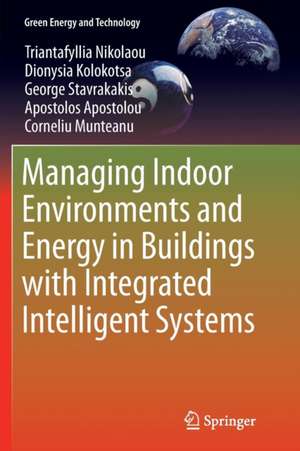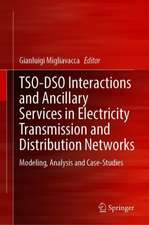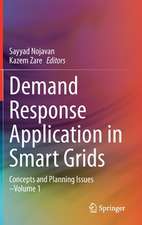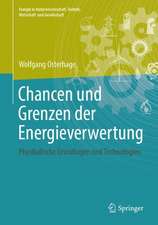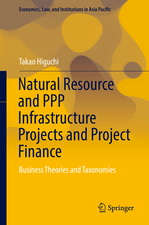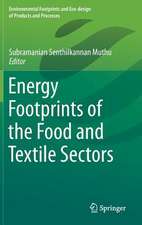Managing Indoor Environments and Energy in Buildings with Integrated Intelligent Systems: Green Energy and Technology
Autor Triantafyllia Nikolaou, Dionysia Kolokotsa, George Stavrakakis, Apostolos Apostolou, Corneliu Munteanuen Limba Engleză Paperback – 22 oct 2016
| Toate formatele și edițiile | Preț | Express |
|---|---|---|
| Paperback (1) | 639.41 lei 6-8 săpt. | |
| Springer International Publishing – 22 oct 2016 | 639.41 lei 6-8 săpt. | |
| Hardback (1) | 645.60 lei 6-8 săpt. | |
| Springer International Publishing – 2 sep 2015 | 645.60 lei 6-8 săpt. |
Din seria Green Energy and Technology
- 18%
 Preț: 943.43 lei
Preț: 943.43 lei - 20%
 Preț: 629.52 lei
Preț: 629.52 lei - 18%
 Preț: 1124.92 lei
Preț: 1124.92 lei - 18%
 Preț: 947.35 lei
Preț: 947.35 lei - 15%
 Preț: 655.92 lei
Preț: 655.92 lei - 18%
 Preț: 957.62 lei
Preț: 957.62 lei - 18%
 Preț: 789.52 lei
Preț: 789.52 lei - 17%
 Preț: 464.55 lei
Preț: 464.55 lei - 15%
 Preț: 645.79 lei
Preț: 645.79 lei - 18%
 Preț: 903.93 lei
Preț: 903.93 lei - 24%
 Preț: 1322.07 lei
Preț: 1322.07 lei - 18%
 Preț: 890.54 lei
Preț: 890.54 lei - 18%
 Preț: 1115.46 lei
Preț: 1115.46 lei - 18%
 Preț: 1117.03 lei
Preț: 1117.03 lei - 18%
 Preț: 949.73 lei
Preț: 949.73 lei - 18%
 Preț: 892.11 lei
Preț: 892.11 lei - 15%
 Preț: 648.24 lei
Preț: 648.24 lei - 18%
 Preț: 997.09 lei
Preț: 997.09 lei - 15%
 Preț: 579.81 lei
Preț: 579.81 lei - 18%
 Preț: 1123.15 lei
Preț: 1123.15 lei - 18%
 Preț: 961.41 lei
Preț: 961.41 lei - 17%
 Preț: 490.22 lei
Preț: 490.22 lei - 18%
 Preț: 904.60 lei
Preț: 904.60 lei - 15%
 Preț: 643.34 lei
Preț: 643.34 lei -
 Preț: 287.90 lei
Preț: 287.90 lei - 24%
 Preț: 634.04 lei
Preț: 634.04 lei -
 Preț: 379.39 lei
Preț: 379.39 lei - 18%
 Preț: 783.20 lei
Preț: 783.20 lei - 18%
 Preț: 1394.84 lei
Preț: 1394.84 lei - 18%
 Preț: 1691.57 lei
Preț: 1691.57 lei - 18%
 Preț: 1112.48 lei
Preț: 1112.48 lei - 15%
 Preț: 592.61 lei
Preț: 592.61 lei - 18%
 Preț: 952.09 lei
Preț: 952.09 lei - 18%
 Preț: 944.19 lei
Preț: 944.19 lei - 18%
 Preț: 891.33 lei
Preț: 891.33 lei - 18%
 Preț: 1252.44 lei
Preț: 1252.44 lei - 18%
 Preț: 789.52 lei
Preț: 789.52 lei - 20%
 Preț: 566.29 lei
Preț: 566.29 lei - 18%
 Preț: 1113.71 lei
Preț: 1113.71 lei - 18%
 Preț: 1114.24 lei
Preț: 1114.24 lei - 24%
 Preț: 590.58 lei
Preț: 590.58 lei - 20%
 Preț: 567.49 lei
Preț: 567.49 lei - 24%
 Preț: 907.48 lei
Preț: 907.48 lei - 18%
 Preț: 952.89 lei
Preț: 952.89 lei - 18%
 Preț: 952.89 lei
Preț: 952.89 lei - 18%
 Preț: 950.52 lei
Preț: 950.52 lei
Preț: 639.41 lei
Preț vechi: 752.24 lei
-15% Nou
Puncte Express: 959
Preț estimativ în valută:
122.35€ • 127.74$ • 101.26£
122.35€ • 127.74$ • 101.26£
Carte tipărită la comandă
Livrare economică 05-19 aprilie
Preluare comenzi: 021 569.72.76
Specificații
ISBN-13: 9783319365855
ISBN-10: 3319365851
Ilustrații: XII, 261 p. 137 illus.
Dimensiuni: 155 x 235 mm
Greutate: 0.39 kg
Ediția:Softcover reprint of the original 1st ed. 2015
Editura: Springer International Publishing
Colecția Springer
Seria Green Energy and Technology
Locul publicării:Cham, Switzerland
ISBN-10: 3319365851
Ilustrații: XII, 261 p. 137 illus.
Dimensiuni: 155 x 235 mm
Greutate: 0.39 kg
Ediția:Softcover reprint of the original 1st ed. 2015
Editura: Springer International Publishing
Colecția Springer
Seria Green Energy and Technology
Locul publicării:Cham, Switzerland
Cuprins
Introduction.- Review and state-of-the-art on methodologies of buildings’ energy efficiency classification.- Office building simulation models and simplified audits.- Detailed audit and detailed case study building model. Virtual building dataset (vbd) for benchmarking and classification of office buildings.- Environmental rating of buildings.- Energy efficiency in the built environment.- Protocol of alternative measures for buildings’ energy efficiency improvement.
Notă biografică
Dr. Triantafyllia G. Nikolaou
Short Biography
Dr. Triantafyllia G. Nikolaou was born in Athens-Greece on April 19, 1977. She holds a degree in Physics, National & Kapodestrian University of Athens, a M.Sc. degree in the field of Energy Production and Management, National Technical University of Athens and a Ph.D. degree in the scientific area of the Energy Performance and Indoor Environment of Buildings, Technical University of Crete. Her research interests and activities include the analysis, simulation, modeling and optimization for efficient energy and environmental performance of buildings, smart building technologies and building energy management systems (BEMS), renewable energy systems and electricity production systems. She has co‐authored relevant books and articles in international referred scientific journals and conference proceedings while she is a peer reviewer in energy-related scientific jou
Regarding her current professional activity, since 2008 she works as a Special Scientific Consultant for Energy and Water Projects Development at the Organization for the Development
of Crete S.A. (O.A.K. S.A.), Chania, Greece. Moreover, since 2010 she works as a Research Fellow in the Electric Circuits and Renewable Energy Sources Laboratory of the Electronic & Computer Engineering Department, Technical University of Crete, Greece.Textul de pe ultima copertă
Featuring a detailed analysis and presentation of innovative researches, methods, algorithms and technologies that deal with integrated intelligent systems for the efficient management of energy and indoor environment in buildings, this book encompasses the regulations, directives and standards regarding the energy and the indoor environment of buildings as well as a literature review and discussion on the current state-of-the-art for buildings’ energy efficiency classification. Maximizing reader insight into this topic with the aid of simulation models for buildings and energy audits at office buildings are presented including tables and figures with the detailed information regarding the parameters, inputs, outputs and the outcomes of the surveys. This book also outlines the development of a Virtual Building Dataset (VBD) of office buildings as an innovative benchmarking and classification tool. The proposed methodology overcomes the difficulties and time required for collecting the necessary massive building constructional and energy bills data by creating them virtually using efficient stochastic simulation and by taking into account all parameters that may affect the energy performance and indoor thermal comfort of office buildings. The knowledge and ideas conveyed by the book are supported with equations and algorithms and 137 colored figures and 55 tables, and features a rich bibliography, references and web sources. The book contains the basic knowledge undergraduateand especially postgraduate courses on the emergent subject of energy management and saving in buildings. The innovative aspects and guides of the book give serious opportunities to the postgraduate students in this scientific area to further develop their research skills and capabilities.
Caracteristici
Presents a detailed analysis of innovative researches, methods, algorithms, and technologies that apply to integrated intelligent systems for the efficient management of energy and indoor environment in buildings Features example equations and algorithms with 137 colored figures and 55 tables to guide the reader Offers guidelines and specific case studies on how to create the individual dataset of the historical energy consumption and management of the building in which methodologies and technologies for energy management are applied Includes supplementary material: sn.pub/extras
